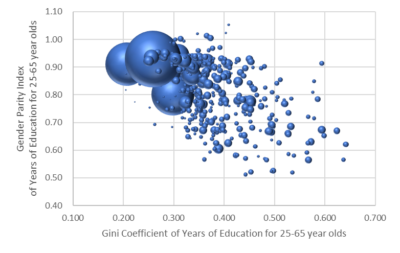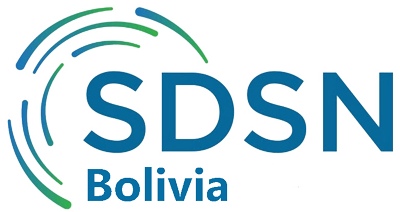April 7th, 2020
While inequality indicators are usually calculated using monetary income or consumption data, they can be calculated on any variable of interest, thus informing us about other types of inequality in society. In this blog we present a new education inequality indicator to be included in our Municipal Atlas of the SDGs in Bolivia.
Using data from the 2012 Population Census we calculated years of education for every person. We then chose the age group 25-65 years, since that is the age group in which most people will have finished their education and are highly likely to be working and using their education. Having learned from our experience analyzing electricity consumption inequality, we calculated a series of different inequality measures in order to figure out which measure would be the best choice. Unlike what we found for electricity consumption inequality, all education inequality measures were highly correlated, so it didn’t matter much which one we use, so we decided to use the Gini coefficient of Years of Education.
The Gini coefficient of Years of Education ranges from 0.205 in Coipasa (Oruro) to 0.642 in Ocurí (Potosí). This is a range in which the Gini coefficient works well and correlates closely with other measures of inequality. La Paz has very low education inequality (Gini = 0.207), while Sucre has the highest level of education inequality (Gini = 0.321) of the 10 main cities.
Many smaller municipalities have much higher education inequality, and as can be seen in Figure 1, this has a lot to do with women having been denied the same education opportunities as men in the past. Very few municipalities have a Gender Parity Index close to 1 (meaning that men and women have the same level of education). In many small, rural municipalities women have only between half and two-thirds of the education of men, and this situation correlates with high education inequality.
Figure 1: Education inequality versus gender inequality in education, by municipality, 2012
 Source: Authors’ elaboration based on data from the 2012 Population Census.
Source: Authors’ elaboration based on data from the 2012 Population Census.
Although returns to education are low in Bolivia, (in terms of future income) and the quality is suspected to be low as well, Bolivians are studying more than ever, so education is clearly considered an important investment by the population. We consider this education inequality variable an important indicator to be included in the Municipal Atlas of the SDGs in Bolivia.
—-
* SDSN Bolivia.
The viewpoints expressed in the blog are the responsibility of the authors and do not necessarily reflect the position of their institutions. These posts are part of the project “Municipal Atlas of the SDGs in Bolivia” that is currently carried out by the Sustainable Development Solutions Network (SDSN) in Bolivia.

 Español
Español